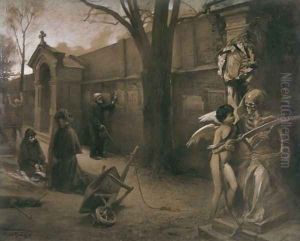Antoni Kamienski Paintings
Antoni Kamiński was a Polish painter, illustrator, and teacher known for his contributions to Polish art during the interwar and post-World War II periods. Born in 1903 in Warsaw, then part of the Russian Empire, Kamiński lived through a transformative period in Poland's history which influenced his artistic development.
Kamiński studied at the Warsaw School of Fine Arts under the tutelage of prominent Polish artists such as Tadeusz Pruszkowski and Wojciech Kossak. His early work was influenced by the Polish Colorist movement and the broader European trends of the early 20th century, particularly post-Impressionism and Symbolism. He developed a distinctive style characterized by bold colors, dynamic compositions, and a focus on the Polish landscape and rural life.
During the 1920s and 1930s, Kamiński became an active member of the Warsaw artistic community, participating in numerous exhibitions and establishing himself as a significant figure in Polish art. His work from this period often reflected his interest in the Polish countryside, folklore, and the lives of peasants, subjects that remained central to his oeuvre throughout his career.
The outbreak of World War II and the subsequent occupation of Poland by Nazi Germany had a profound impact on Kamiński's life and work. He faced artistic restrictions under the occupation, and like many of his contemporaries, he struggled to continue his practice in the face of adversity. Despite the challenges, Kamiński managed to survive the war and resumed his artistic activities following the liberation of Poland.
In the post-war years, Kamiński's style evolved as he adapted to the changing political and cultural landscape of communist Poland. While he continued to draw inspiration from Polish traditions and the natural world, his work from this period also reflects the socialist realism style that became dominant in the Eastern Bloc, albeit with his personal interpretation and subtleties.
Kamiński was not only a painter but also a respected educator. He dedicated a significant portion of his career to teaching, influencing a new generation of Polish artists. His commitment to art education was a testament to his belief in the power of art to shape society and the importance of cultural continuity.
Kamiński's contributions to Polish art were recognized with numerous awards and honors during his lifetime. He continued to paint and exhibit his work until his death in 1978. Today, his paintings can be found in many Polish museums and private collections, serving as a reminder of his artistic legacy and the rich cultural heritage of Poland.
